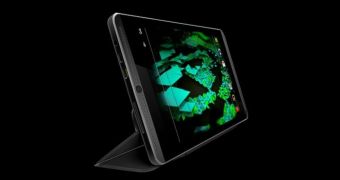Some of you might remember that back in December 2013 it was revealed that AMD was looking to penetrate the tablet ecosystem by bringing forth its own branded device dubbed “Project Discovery.”
The whole thing apparently started because AMD had an interest in making tablets for gamers and some voices claimed that products like the PS Vita and Nintendo 3DS were in for some hefty competition when Discovery was to be launched.
However, since December, the tablet has been teased here and there, but nothing consistent has been heard of its launch.
And as we have seen this week, AMD got beaten to the punch by NVIDIA, which has just rolled out a gaming tablet, called the Shield.
The NVIDIA Shield tablet, successor to the Tegra Note 7 that was launched last year, has been popping in the rumor mill for some time now.
The mobile gaming device comes sporting NVIDIA’s new Tegra K1 system-on-chip that has four ARM Cortex A15 cores running at 2.3GHz each plus a fifth, slower core that takes over when nothing too demanding is performed on board.
A gaming tablet running Tegra K1, which has been shown in benchmarks to be capable of pushing quite far in the performance department, makes a lot of sense for NVIDIA. Especially since they are also gearing up to launch the Shield 2 gaming console.
Unlike the first Shield, it will not come with a display, since streaming to larger displays and all-in-one systems is the main focus now.
For those who can’t handle having a gaming device without a screen, the NVIDIA Shield tablet will be the answer. The slate comes with support for 4K video output (or 3840 x 2160 pixel resolution), so customers will be able to stream their gameplay to larger displays if they feel like it, too.
Compared to the Tegra Note 7, which was a simple consumer-bound tablet, the Shield tablet comes with full HD screen (1920 x 1200 pixels), so game graphics should be rendered pretty smoothly.
Like with AMD’s Project Discovery, the Shield tablet is offered with a dedicated Shield controller for those who don’t like the idea or playing PC games using on-screen controls.
As opposed to many wireless controllers, the Shield uses Wi-Fi Direct instead of Bluetooth to deliver a lower-latency performance. What’s more, you can connect up to 4 different controllers to a single Shield tablet.
So folks who were complaining that tablets wouldn’t amount to much in the gaming industry due to the lack of physical buttons might rethink their position after they have a go at the new NVIDIA slate.
NVIDIA says the Shield tablet should cater to the needs of mobile gamers, kind of like the Nintendo 3DS and similar products should. So is the NVIDIA Shield tablet the first wave of true gaming tablets that will unleash the fall of the gaming consoles?
It appears to us that the answer might be yes. For starters, all around the world, the tablet market has obviously begun to mature.
That means that device manufacturers must think of ways to diversify their offerings in order to stand out from the competition, and one of the ways to do that is to specialize.
So we have seen tablets go into healthcare, the restaurant business, schools, and the professional field. Now NVIDIA is attempting to build another niche by delivering the first consumer-friendly tablet optimized for gaming.
With the new device, users will be able to tap into local PC games, cloud PC games, and console games (if you purchase the Shield wireless controller).
Moreover, the Shield tablet comes with support for game-casting to Twitch, the app that accounted for more than 850 million minutes of content viewed by 2.6 unique viewers. And we’re talking only about the Android version.
However, at this point it’s pretty early to know for sure what will happen, but surely time will show us whether we were right or wrong in our predictions.

 14 DAY TRIAL //
14 DAY TRIAL //